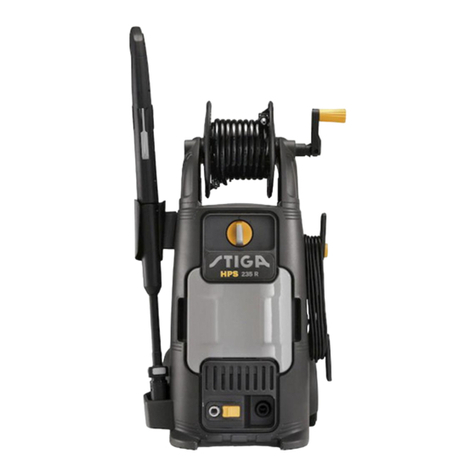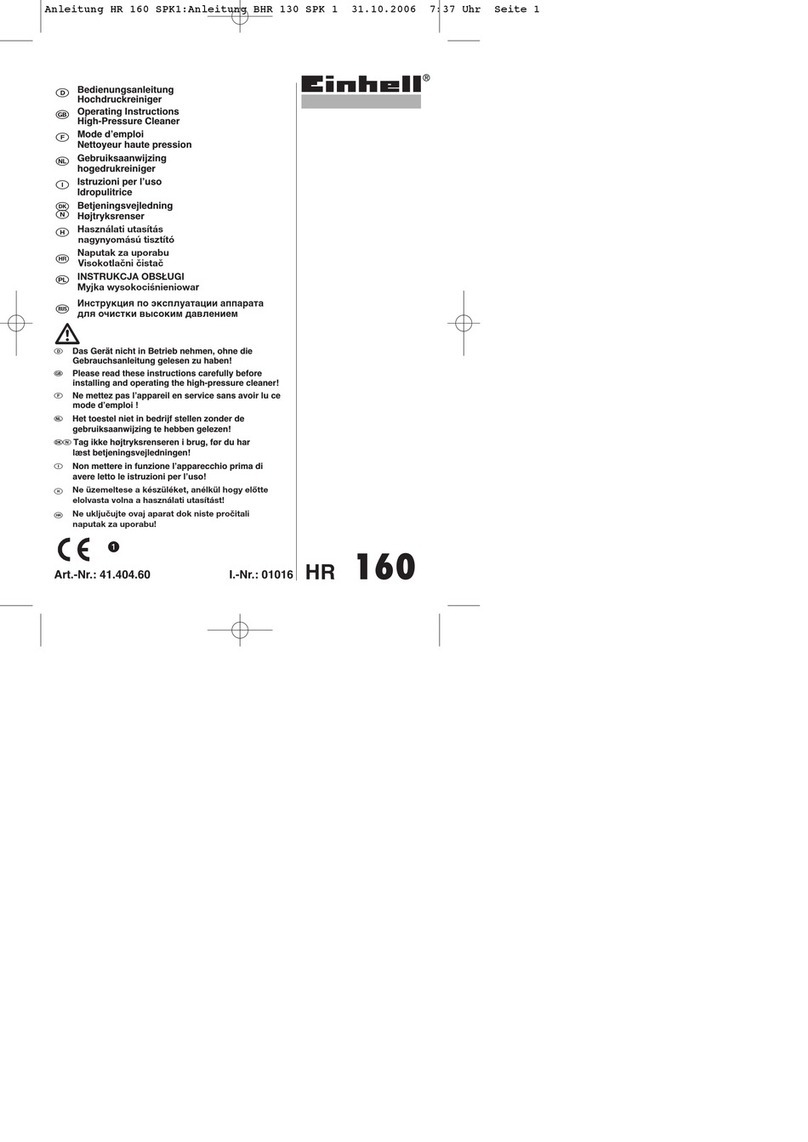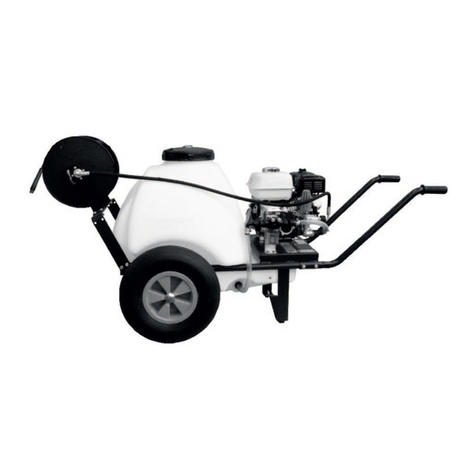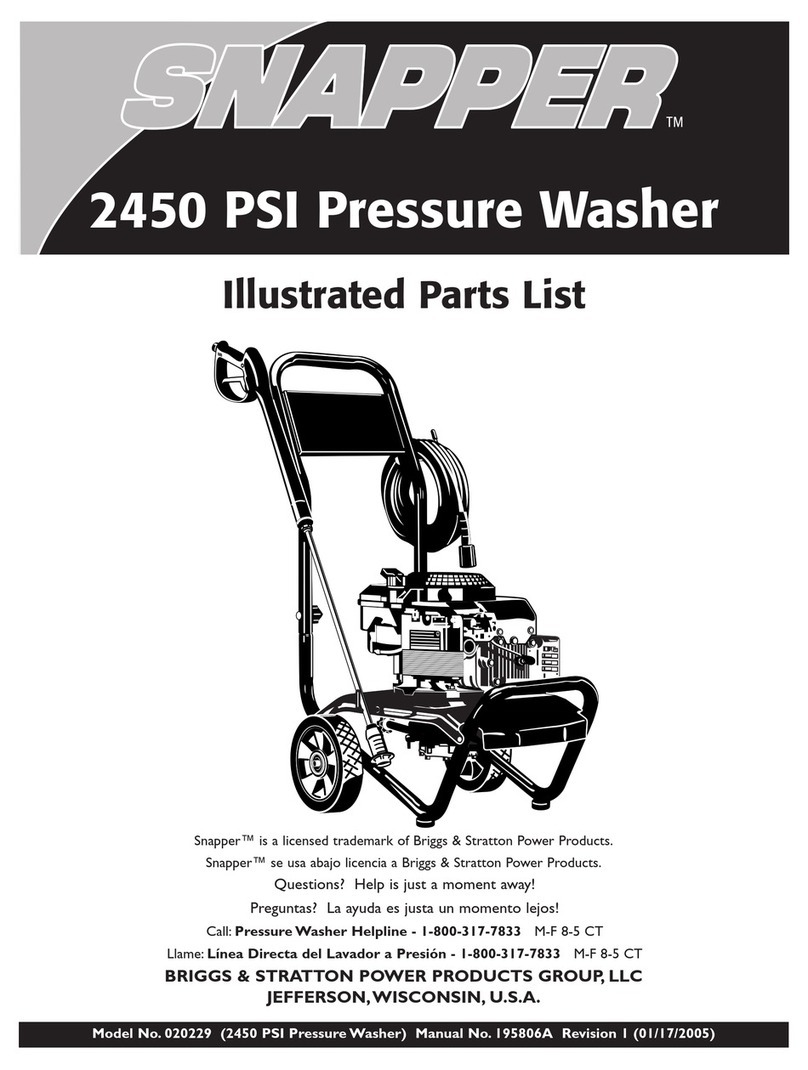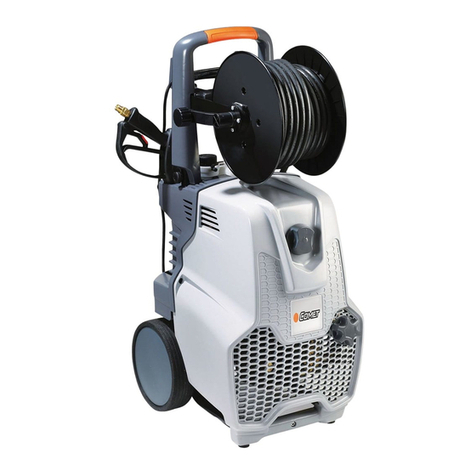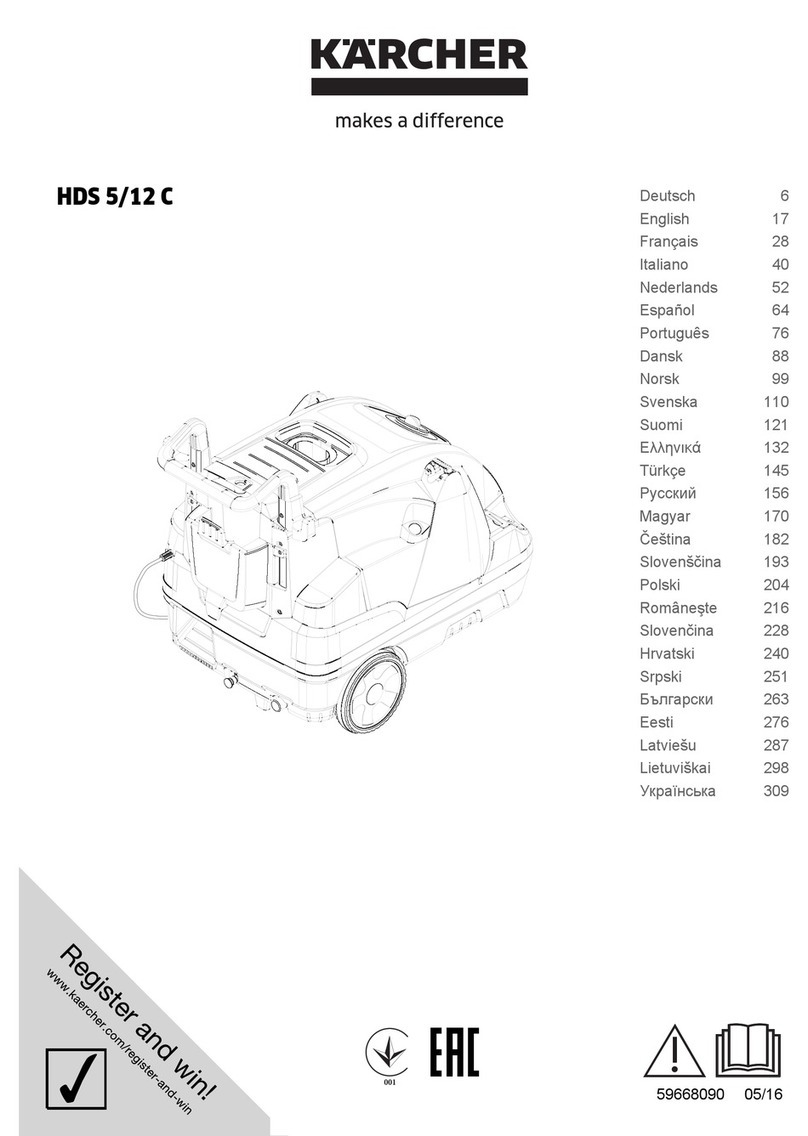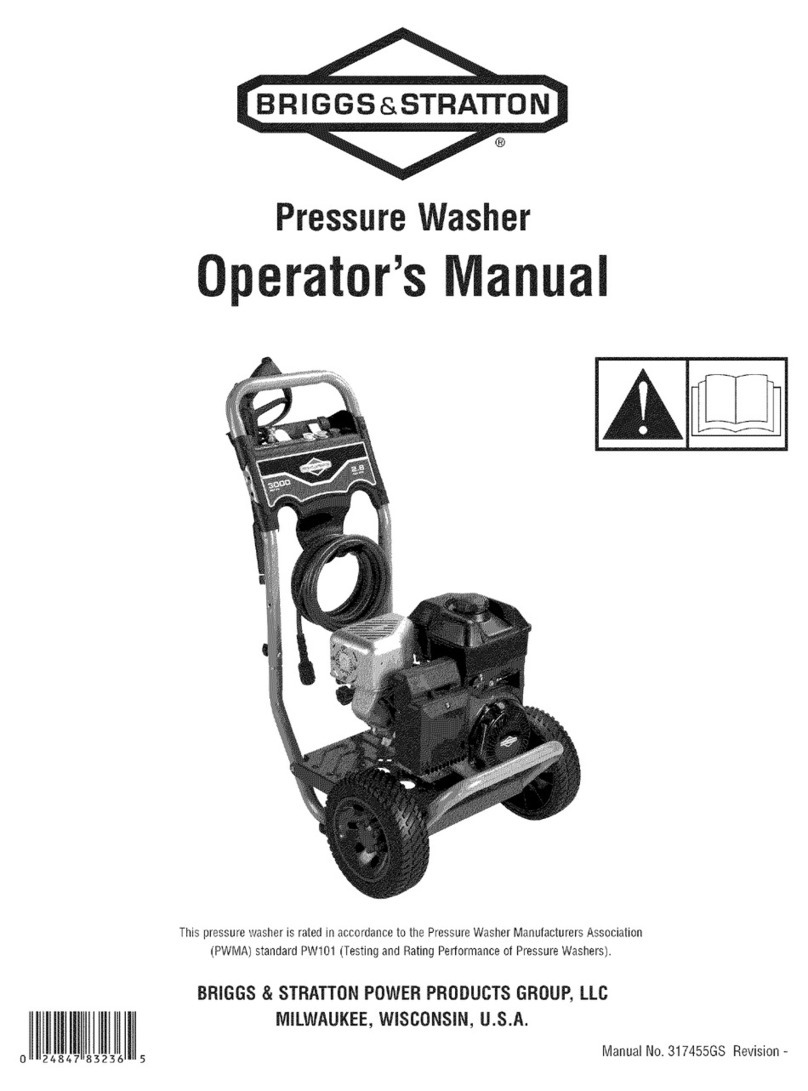Metalcraft KPR-2.3 User manual

-
OPERATOR’S MANUAL
HIGH PRESSURE WASHER KPR-2.3
-EN-

1
IMPORTANT!
Safety instructions
All operators must read these instructions
before use.
WARNING!
This indicates dangerous situations which,
if not avoided, can result in death or serious injury.
CAUTION!
This indicates dangerous situations, which
if not avoided, can cause moderate injury.
DANGER!
This indicates dangerous situations, which if
not followed, can result in death or serious injury.
General safety
WARNING!
This appliance is not intended for use by
children or unassisted, unsupervised, person whose physical,
sensory or mental capabilities prevent them from using it safely.
Children must be supervised by adults to ensure they do not
play with the appliance.
Before starting up your machine, carefully check the integrity /
defectiveness of the product. If you find any, do not start up your
machine.
WARNING!
When using the pressure washer, basic
safety precautions should followed to reduce the risk of fire,
electric shock, personal injury. These include:
Know your product:
You need to know how to stop the
pressure washer and quickly bleed the pressure,
familiarize yourself thoroughly with these controls
Keep by standard away:
Visitors and pets must be kept
at a safe distance from the work and spray area.
Use the pressure washer properly:
Do not use the
appliance for any job outside its intended purpose.
Dress properly:
Do not wear loose clothing or jewelry.
They can be carelessly taken during the movements of the
parties. Protective rubber gloves, non-slip footwear,
protective goggles are recommended during use.
Caution!
Exercise caution to avoid slipping or falling.
Wear protective footwear with rubber soles to protect
yourself and improve your support without the risk of
slipping.
Stay alert:
Watch what you are doing. Use common sense.
Do not use the device when you are tired, or under the
influence of alcohol or drugs.
Don't overreach:
keep proper footing and balance in all
phases of use.
Avoid unintentional starting:
Do not move or pull the
appliance without disconnecting the plug from the socket.
Do not pull the device through the gun handle. Make sure
that the switch is in the "zero Off" position before insert the
plug into the electrical socket.
Do not abuse the electric cable:
Do not move or pull the
appliance through the cable, do not yank it to remove it
from the electrical socket. Keep the cable away from
sources of heat, oil or gasoline, sharp edges.
Use Protective Safety glasses:
Use rubber-soled safety
shoes, tight-fitting clothing, protective rubber gloves, ear
protection and safety hat.
Store indoors: Never
store the appliance outdoors or at
risk of freezing. The device can be seriously damaged and
compromise safety.
Check the water temperature
: the pump cannot work
with hot water above 40
o
C
,
causing serious damage to
the pump and accessories.
Inspect the electric cable
: the insulation of the power
cable must always be intact. If the cable is damaged or
shows any signs of cuts or wear, do not use the appliance.
If the device is equipped with a H05VV-F (PVC) cable it
cannot be used below the temperature of 32
o
F (0
o
C).
WARNING!
Comply with local laws on the use of water.
In accordance with EN 12779 (BA) the equipment can be
connected to the water supply only if the supply pipe is
equipped with a non-return valve. Contamination hazard.
WARNING!
Do not use the appliance without carefully
reading this user manual.
WARNING!
This appliance has been designed for the
use of chemical products compatible with car washing and not
particularly aggressive, recommended by the manufacturer.
The use of products not compatible with materials such as NBR
rubber can compromise the safety of the appliance.
OPERATOR’S MANUL
HIGH PRESSURE WASHER

2
WARNING!
Do not use the appliance if people or
animals are within range of actions.
WARNING!
The high pressure jet can be dangerous if
used improperly. The jet must not be directed against people,
animals, connections or electrical panels, the pressure washer
itself, pneumatic valves.
Do not direct the jet at yourself or others to clean clothes or
shoes
Risk of explosion:
Do not spray flammable products.
Device disconnection:
Disconnect the device from the
electrical outlet before carrying out any maintenance
Keep children away:
This pressure washer should not be
used by children or untrainned personnel
To ensure appliance safety , use only original spare parts
from the manufacturer or approved by the manufacturer.
WARNING!
The water that has passed through the
inlet pipe, pump, accessories is to be considered non-potable.
WARNING!
During cleaning, maintenance, or
replacement parts, the appliance must be electrically and
hydraulically disconnected.
WARNING!
High pressure hoses, accessories,
connections are important for the operational safety of the
device. Use only original or manufacturer recommended hoses,
connections, accessories.
check if the parts are damaged: do not use the appliance if
the electrical cable, or other important parts (eg. Safety
devices, high pressure hose, gun, nozzle) are damaged.
WARNING!
If you use electrical extension cables, the
plug and socket must be watertight.
WARNING!
Inadequate electrical extensions can be
dangerous.
This pressure washer cannot be used at temperatures
below 32'F (0'C).
WARNING!
Power cords on drums should always be
completely unwound to prevent the cord from overheating.
The power cord must be kept dry and off the ground.
If the power cord is damaged, do not use the appliance
and contact the seller.
Keep the device during use and storage on a stable base
and flat surface,
In the event of an accident or breakdown, immediately turn
off the appliance and wash with plenty of water if you come
into contact with detergents.
Electrical safety
ATTENTION:
If there are problems with the electrical MAINS,
electrical voltage drops, this may occur when the appliance is
started. This in turn can affect other electrical equipment (eg
flashing lights). If the network impedance Zmax <0.335 OHM,
these disturbances are not expected (in case contact the
seller).
WARNING!
Electrical shock hazard: Before each use
of the appliance, carefully check for any defects or damage. If
you find any, contact the seller and do not use the device.
The following instructions must be observed when connecting
the pressure washer to the electric supply.
The power supply system must be performed by qualified
person.
IMPORTANT:
Only use water without any impurities. If there
is a risk of sand in the feed water, an additional filter should be
installed.
Safety devices
The unloader valve can reduce the pressure in case it exceeds
the set value. The spray gun is equipped with a lever locking
system to be activated when the appliance is left unattended.
When activated, the spray gun cannot be used operationally.
1.
Thermal sensor - A thermal sensor device is installed to
prevent the motor from overloading. The machine restarts
after a few minutes when the thermal sensor has cooled.
2.
Double Insulation - In double insulated appliances, two
insulation systems are applied in place of grounding. There
is no grounding system and no grounding system must be
added. Any maintenance on appliances with double
insulation requires knowledge and extreme care. Double
insulated devices are marked with the wording "double
insulation" or with the double square symbol.
3.
The appliance's electrical connection network must be
performed by qualified personnel and comply with the IEC
60635-1 standard. The power supply must include a
protective device for leakage currents (lifesaving) which
interrupts the supply of electricity if a loss of more than
30mA occurs for 30ms, or a device that tests the circuit to
earth leakage.
4.
This pressure washer cannot be used at temperatures
below 32'F (0'C).

3
5.
To reduce the risk of electric shock, for the US market the
device is equipped with a polarized plug (one plug is wider
than the other). The appliance plug can only be inserted
into the socket in one direction and not the other.
If you can't insert the plug into the socket, try turning the
plug in the other direction. If it does not insert, make sure
the socket is polarized, otherwise contact qualified
personnel to install the correct socket.
Do not
modify or
replace the appliance plug in any way.
6.
To prevent electrical disconnection with the extension cable,
tie a knot between the cables as shown in Figure 1.
Figure 1. Method of securing extension cord
If you use electric extension cables, the plug and socket
must be waterproof. Do not abuse the electric cable: Do
not move or pull the appliance through the cable, do not
yank it to
remove it from the electrical outlet. Keep the cable away
from sources of heat, oil or gasoline, sharp edges.
Risk of electrocution
Inspect cord before using
Do not use the appliance if cord is damaged
Keep all connections dry and off the ground
Do not touch the plug with wet hands
Keep the cable away from heat sources and sharp edges
Do not spray on the appliance and electrical apparatus and
wiring.
Risk of explosion
Do not spray / use flammable liquids
Do not use acids, solvents or any flammable materials on
this product. These substances can cause physical injury
to the operator and irreversible damage to the appliance. -
Do not cover or obstruct the appliance with rags or other.
Maintain proper cooling from the slots.
Additional safety instructions
High pressure: keep the nozzle clean
Injection hazard: the device can cause serious injuries if
the spray penetrates the skin
Do not point the spray gun and the water jet at any person
or any part of the body
In case of skin penetration, contact a doctor immediately
Before servicing, clean or remove any part, disconnect the
electricity by removing the plug from the socket. Discharge
the residual pressure in the gun by turning off the device
and pulling the lever 2 times for 3 seconds.
This machine is not suitable for connection to the drinking
water network.
Product description
Purpose
This pressure washer has been designed for domestic use
outdoors. Not for professional use. Ideal for cleaning
vehicles, machines, buildings, facades, sidewalks etc ...
Areas of application
Avvertenza
!
!
Electric shock may cause severe injury or death.
Heed these warnings.
Do not allow any part of the pressure washer to come into
contact with water during use. If the appliance gets wet, you
must turn off the switch and clean and dry it.
For any electrical extensions see the below chart.
Do not touch the appliance or its plug with wet hands or if your
feet are in the water. Wearing rubber boots offers decent
protection.
EXTENSION CORD CHART
Cord Length (m):
10
Min. Wire Gauge (mm
2
):
1.5
Cord set
Appliance cord
(A)
Tie cord as shown.
(B) Connect the plug and socket with the switch off.

4
Never use in potentially explosive areas
The operating temperature of use must be between 0'C
(32'F) and 40'C (104'F)
The device consists of an assembly with pump and motor
inside a shockproof enclosure. To allow the operator
optimal use, the machine is equipped with a gun, extension,
nozzle and handle as per
reference.
Do not obstruct or modify the spray nozzle in any way
The pressure washer is designed to be used with cold or
warm water. Too hot water can seriously damage the
pump.
Do not use feed water if it is dirty, grainy, or contains
chemicals. It could compromise the operation and life of
the appliance.

5
Safety symbols
The following table depicts and describes safety symbols that may appear on the product. Read, understand and follow the instructions
before attempting to use the device.
Symbols
Description
Symbols
Description
Read the instruction booklet (s) -
Read understand and follow the
instructions in the manual (s) before
use / assembly.
Warning!
Risk of electric shock.
Safety Alert -
Indicates a precaution,
a warning, or a hazard.
Warning!
Do not expose the device to
rain, snow and wet conditions. Keep it
dry.
Wear eyes and hearing protection -
To protect yourself against injury, wear
ear muffs and protective eyewear.
To reduce the risk of injury, the user
must keep everyone at least 15m
(49ft) away from the area of use.
Wear safety gloves during use to
protect your hands.
Wear non-slip footwear that can
protect your feet and improve your
support on slippery surfaces.
Store indoors. Never store the
pressure washer outdoors. Permanent
damage can occur if the pump
freezes.
Machine not suitable for connection
to drinking water.
Always keep the electric cable away
from heat sources, oils or sharp
edges. Remove the plug immediately
if the cable is damaged, frayed or
entangled.
Warning!
Turn off the appliance (0 / Off
switch) and disconnect it from the mains
before inspecting, cleaning, maintaining
it, changing accessories, or conducting
any other type of maintenance or
intervention.
Sound level is 92 dB (A)
Double Insulated -
During
maintenance, use only identical
replacement parts.

6
Know your electric pressure washer
Unpacking
Packaging contents
10.
15.
Technical Specifications
Voltage/Frequency 220-240V/50-60HZ
Power 1900W
Working Pressure 100Bar
Max Pressure 150Bar
Rate Flow 5.5L/min
Max Flow 7.5L/min
8.
16.
Read the owner’s manual and safety instructions carefully before using the electric pressure washer. Compare the illustrations below with
the device in order to familiarize yourself with the various controls and accessories. Save this manual for future reference.
FRONT
BACK
1. Safety lock
2. Trigger
3. Trigger gun
4. Spray wand
5. Adjustable Nozzle
6. High pressure hose
7. Transportation handle
8. Trigger gun holder
9. Spray wand & trigger gun holder
10.Sprayer
11.Wheels
12. Water outlet
13. Power cord
14. On/Off switch
15. Water inlet connector
11.
2.
5.
12.
3.
9.
1.
14.
4.
7.
6.
13.
8.
10.
15.

7
Pressure washer unit
Handle
High-pressure hose
Trigger gun
Spray wand
Quick-connect nozzle
Removable detergent tank
Trigger gun holder
Garden hose adaptor
Manual with registration card
1.
Carefully remove the pressure washer and check if all the
above-mentioned contents are present in the packaging.
2.
Inspect the product carefully to verify that no transport
damage or breakages are present. If you find any type of
damaged or missing part DO NOT return the product,
please contact your seller.
NOTE:
Do not throw away the packaging and packaging
material until you use the pressure washer. The packaging is
made with recyclable material. Properly dispose of materials
according to local regulations.
Important!
The appliance and the packaging materials are
not toys. Do not allow children to play with plastic bags, foil, or
small parts. These parts can be swallowed or pose a choking
hazard !!!
WARNING!
Do not connect the device to the power
outlet until you have finished the assembly. Failure to comply
could cause an inadvertent departure with possible consequent
injuries.
Assembly
1.
Place the pressure washer near the water source.
2.
The pressure washer must be used on a safe, stable, not
inclined, vertical position (fig.1).
3.
Insert the handle into position until you hear a "click" (fig. 2).
4.
Engage the extension on the gun and rotate until it fits
completely. Pulling the extension must not come out of the
gun (fig. 3).
Spray gun
Extension

8
5.
Connect the high pressure hose to the spray gun by
pressing the lever and releasing it when it fits (fig. 4).
6.
Connect the high pressure hose to the pump outlet (fig. 5).
WARNING!
Keep the high pressure hose away from
sharp or angular parts. The bursting of the tube can cause
injuries. Check the tube periodically and replace it with an
original one if damaged. Do not try to repair it if it is damaged.
7.
Connect the female adapter of the garden hose to the male
at the pump inlet (fig. 6). The garden hose must be at least
13mm (1/2 in.) Inside diameter and reinforced type. The
water flow rate must be at least 1.5 times the pump flow
rate.
NOTE:
The machine is not suitable for connection to the
drinking network.
8.
Connect the garden hose to the tap (fig. 7).
9.
Self-priming (fig. 8).
WARNING!
The supply water cannot exceed 40'C
(104'F), and 0.7MPa of pressure.
WARNING!
Do not use feed water if it is dirty, grainy,
or contains chemicals. It could compromise the operation and
life of the appliance.
10.
Make sure that the switch is in the OFF position (0)
before connecting the plug to the power socket (fig. 9).
WARNING!
Before turning on the appliance (on / I)
open the water inlet tap and pull the lever of the spray gun.
In this way you let the air contained in the duct escape.
Make sure there are no water leaks from the connections.
High pressure hose
Spray gun
High pressure hose
High pressure pump outlet
(REAR)
Garden hose
Water inlet
FRONT
Part to be connected
to the pump inlet
Garden hose
Connect to the garden hose water source
Self priming garden hose
(no more than 9.8ft, 3m)
Water filter

9
11.
Insert the nozzle in the extension. Once inserted, the
red button must return to the raised position (fig. 10).
12.
To disconnect the high pressure nozzle from the
extension:
1.
Turn off the pressure washer (switch 0 / OFF), close
the inlet water supply, pull the gun lever to discharge
the residual pressure
2.
Remove the nozzle by pressing the red button and
pulling outwards.
WARNING!
Do not make changes on the nozzle when
the gun lever is pulled. It can cause damage to the appliance and
injure the user.
Working with detergents
When cleaning with the pressure washer, some tasks can be
accomplished with water only. Others require the use of
detergent for more effective cleaning.
WARNING!
Use only detergents suitable for high
pressure washers.
DO NOT USE
household cleaners, acids,
alkaline solutions, solvents, bleach, flammable liquids, solutions
for industrial use. Many detergents may require dilution before
use. Prepare the solution as per the instructions on the bottle.
1.
Fill the bottle with the detergent, max 300ml (fig.11 & 12).
CAUTION!
Always test the cleaner on an
inconspicuous area before using it.
2.
Turn on the switch (pos. I / ON). Pull the lever of the spray
gun to make the pressure washer operational. The liquid
contained in the tank will be automatically dispensed and
mixed with the water.
3.
Apply the detergent from bottom to top on dry surfaces.
NOTE:
wetting the surface first is not recommended as it
would further dilute the detergent, reducing its
effectiveness.
4.
Allow the detergent to remain on the surface for some time
before rinsing. Do not let the cleaner dry on the surface.
NOTE:
in the event that the dispenser does not suck up
the detergent, try rotating the nozzle to an intermediate
spray position (medium fan).
CAUTION!
Damage can be caused to painted
surfaces if the product is allowed to dry without rinsing. Avoid
working on surfaces that are too hot or in direct sunlight.
5.
When you have finished using the detergent dispenser,
remove the head from the tank, fill the tank with water and
dispense in order to clean the internal ducts of the
dispenser itself. Remove the dispenser and rinse it
thoroughly to clean it.
CAUTION!
Failure to observe the above instructions
causes the detergent dispenser to become clogged and not
working.
Rinsing with the pressure washer
1.
Switch off the pressure washer and close the supply water
2.
Press the trigger of the gun to release the residual pressure
3.
Activate the safety lever lock
Detergent for
pressure washers
Detergent tank
Detergent dispenser

10
4.
Select the right spray angle of the jet from the nozzle by
turning the knob (fig. 13).
5.
Start from the top of the area to be rinsed downwards,
making sure there is support between one section and the
next.
IMPORTANT!
NEVER USE
Bleach, chlorine products, and other corrosive products
liquids containing solvents (e.g. paint thinners, petrol, oils)
Sodium phosphate
Ammonia
Acid-based products
These products damage the appliance, accessories and
surfaces.
Shutting down
1.
Turn the switch on 0 / OFF and remove the plug from the
socket.
2.
Close the inlet water
3.
Pull the gun lever to relieve residual pressure two or three
times
4.
Disconnect the water inlet hose
5.
Disconnect the high pressure hose from the pressure
washer and gun
6.
Activate the safety lever locking device
WARNING!
Turn off the pressure washer, turn off the
water, press the spray gun lever to discharge the residual
pressure. Failure to comply with this can cause injuries due to
pressure relief from the pressure washer.
Taking a break
If you want to take a break of 5 minutes or more between
cleaning, you need to:
1.
Activate the safety lever lock device
2.
Turn off the appliance (turn the switch to 0 / OFF)
3.
Remove the plug from the socket.
Storage
CAUTION!
Always store your pressure washer indoors
with temperatures above 0'C (32'F). The pump may be
permanently damaged if it freezes. Damage from freezing is not
covered by the warranty.
CAUTION!
The use of antifreeze liquid is
recommended to prevent damage due to the cold during the
winter.
Winterizing and long-term storage
If you must store the pressure washer in a place with
temperatures below 0C (32'F), you can minimize the possibility
of damage by following the following procedure:
Disconnect the water inlet and outlet pipes
Turn on the switch (1 / ON) for a few seconds to let the
residual water out of the pump, then turn it off immediately
(0 / OFF)
Do not twist the high pressure hose
Store the appliance and accessories in a room where there
is no risk of freezing
Do not store the appliance near furnaces or other heat
sources that may melt or excessively dry the internal parts
of the pump and accessories
Add a non-corrosive, non-toxic, anti-freeze liquid to the
pump for the winter period
WARNING!
Before using the appliance again, rinse the
pump completely with clean water. Anti-freeze products can
damage paints, so be sure to eliminate the anti-freeze in the
system before any type of cleaning.
Maintenance
CAUTION!
Before working on the pressure washer,
disconnect the plug from the power socket. 1.To ensure good
FRONT

11
performance, check and clean the water inlet filter (fig. 14).
Remove the filter and rinse with hot water to prevent any
foreign parts from entering the pump.
Circuit diagram
A circuit diagram for the pressure washer is provided below for
your reference (Fig.15)
The unit is designed for continuous use.
Troubleshooting
M = M
otor
T = T
hermal protection
Power cord
Micro-switch
Disconnect the unit from the electrical power supply before carrying out maintenance on the machine or when checking that its
parts are in proper working order.
To avoid unnecessary hassles, consult the following table before contacting customer service with any mechanical issues.

12
Problems
Possible cause
Solution
Machine refuses
to start
Power failure/machine not plugged into
working receptacle.
Defective socket
Fuse has blown
Defective extension cord
Check to make sure machine is plugged into a working outlet
Check the power cord, try a different outlet
Replace the fuse. Switch off any other machines that are using the
same circuit.
Try the unit without an extension cord
Fluctuating
pressure
Pump sucking air
Valves dirty, worn out, or stuck.
Pump seals worn out
Check the hoses and connections are airtight
Clean or replace valves/seals
Please contact the seller
Machine stops
Fuse has blown
Incorrect mains voltage
Thermal sensor activated
Nozzle partially blocked
Replace fuse. Switch off other machines using the same circuit
Check that the main voltage corresponds to specifications on the
model tag
Leave the washer for 5 minuted to cool down
Clean the nozzle
Fuse to blows
Fuse too small
Install a fuse with higher Ampere rating than the Amp consumption
of the machine. Try the unit without an extension cord.
Machine
pulsating
Air inlet hose
Inadequate supply of mains water
Nozzle filter blocked
Hose kinked
Allow machine to run by holding the trigger until regular working
pressure resumes
Check thet the water supply correcpond to the specifications
required
WARNING!
Avoid using long thin hoses
(Min 1/2 in. 13mm Diameter)
Clean the nozzle
Clean the water inlet filter
Straighten out the hose to remove any kinks/blockages
Machine often
starts and stops
by itself
Pump/spray gun is leaking
Trigger mechanism is broken
Please contact the seller
Machine starts,
but no water
comes out
Pump/hoses or accessories frozen
no water supply
Water inlet filter blocked
Nozzle blocked
Wait for pump/hoses or accessories to thaw
Connect inlet water
Clean the water inlet filter
Clean the nozzle

13
NOTE:

14
Table of contents

